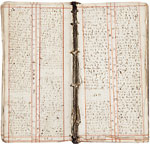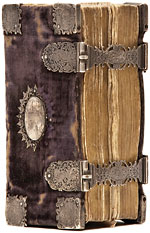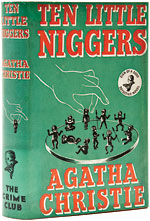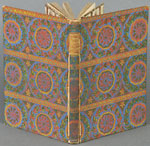The Wright Stuff
Short-Writing the Good Book
Seventeenth-century manuscript bible in short hand, £5,855 ($8,900) at Bloomsbury Auctions on July 8.
One of the more unusual bibles seen at auction in recent months, this manuscript is titled “This Booke containeth the Ould and New Teastement with the Psalmes written per me; Joseph Alstone.” Using Thomas Shelton’s short-writing or tachygraphy system, it was compiled by a Chelsea merchant and younger brother of the physician, Sir Edward Alston. Some leaves are now loose but in the original velvet binding, with its silver fittings and chased decoration of biblical scenes, etc., it had undoubted appeal and novelty value.
And Then There Were None
Agatha Christie, Ten Little Niggers, £1,340 ($2,105) at Bloomsbury Auctions on August 12.
Quite understandably, the Agatha Christie bestseller as seen is not something that is tolerable nowadays, and while such a title may have been acceptable in 1930s England, later editions of Agatha Christie’s best-selling novel were called Ten Little Indians—with appropriate changes to the text. I have even seen it reported that Ten Little Soldiers has been used when the use of term Indians has been considered politically and ethnically insensitive.
In America, where the original title was always likely to prove even more inflammatory, it was published from the start as And Then There Were None, but this is how it looked when first issued in England as a Collins Crime Club title in 1939.
The jacket of this copy, which has seen some skilful restoration to the edges, is unpriced, and the auctioneers suggest that it may have been a copy intended for export.
Wilde About the Girl
Oscar Wilde, Salomé, £39,950 ($61,125) at Dominic Winter in South Cerney on July 21.
They may never have met and there is no mention of Gustave Moreau’s name in Wilde’s letters, but it is generally accepted that the French symbolist painter was a major influence on Wilde when he came to write Salomé. Biographer Richard Ellmann says his principal inspirations were an account in Huysmans’ A Rebours of two paintings by Gustave Moreau and, in the same book, a quotation from Mallarmé’s Hérodiade.
Moreau’s Salomé paintings caused a sensation at the Paris Salon of 1876, and Salomé as femme fatale became something of an obsession for the artist, who produced nineteen paintings, six watercolors, and some 150 drawings on the theme.
The Wildean link with Moreau was underlined by the appearance of this previously unknown copy of the 1893, Paris first edition, inscribed “á Gustave Moreau, Hommage respectueux, Oscar Wilde.” The original purple wrappers, printed in silver, are faded and browned at the margins, but preserved (along with a tipped-in silver print of a Moreau watercolor of Salomé dancing) in a period binding of boards with stencilled floral decoration and endpapers decorated with gilt designs of saints.
After 1880, Moreau never again exhibited at the Salon or anywhere else and refused to allow his pictures to be reproduced. The auctioneers wondered where the photograph of the Moreau watercolor came from: Was it Moreau or Wilde who inserted it, and could the binding decorations be by Moreau?
Wilde began writing Salomé in 1891 and it was already in rehearsal in London, with Sarah Bernhardt as Salomé, when the Lord Chamberlain refused a license on the grounds that the play introduced biblical characters. It was first staged at the Théâtre de l’Oeuvre in Paris in 1896.








 Ian McKay’s weekly column in Antiques Trade Gazette has been running for more than 30 years.
Ian McKay’s weekly column in Antiques Trade Gazette has been running for more than 30 years.


